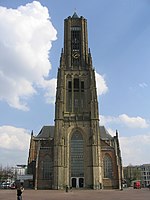Battle of Arnhem

The Battle of Arnhem was a battle of the Second World War at the vanguard of the Allied Operation Market Garden. It was fought in and around the Dutch city of Arnhem, the town of Oosterbeek, the villages Wolfheze and Driel and the vicinity from 17 to 26 September 1944. The Allies were poised to enter the Netherlands after sweeping through France and Belgium in the summer of 1944, after the Battle of Normandy. Operation Market Garden was proposed by Field Marshal Sir Bernard Montgomery, who favoured a single push northwards over the branches of the Lower Rhine River, allowing the British Second Army to bypass the Siegfried Line and attack the Ruhr. US Airborne troops were dropped in the Netherlands to secure bridges and towns along the line of the Allied advance. Farthest north, the British 1st Airborne Division landed at Arnhem to capture bridges across the Nederrijn (Lower Rhine), supported by men of the Glider Pilot Regiment and the 1st Polish Parachute Brigade. The British XXX Corps were expected to reach the British airborne forces in two to three days. The 1st Airborne Division landed some distance from its objectives and was hampered by unexpected resistance, especially from elements of the 9th and 10th SS Panzer Divisions. Only a small force was able to reach the Arnhem road bridge while the advance of the main body of the division was stopped on the outskirts of the town. XXX Corps was unable to advance north from Nijmegen in the Battle of Nijmegen as quickly as planned and the British airborne troops were not relieved according to schedule. After four days, the small British force at the bridge was overwhelmed and the rest of the division trapped in a small pocket north of the river. The paratroops could not be sufficiently reinforced by the Poles or XXX Corps when they arrived on the southern bank, nor by Royal Air Force supply flights. After nine days of fighting, the remnants of the division were withdrawn in Operation Berlin. The Allies were unable to advance further with no secure bridges over the Nederrijn and the front line stabilised south of Arnhem. The 1st Airborne Division lost nearly three quarters of its strength and did not see combat again.
Excerpt from the Wikipedia article Battle of Arnhem (License: CC BY-SA 3.0, Authors, Images).Battle of Arnhem
Rijnkade, Arnhem
Geographical coordinates (GPS) Address Nearby Places Show on map
Geographical coordinates (GPS)
| Latitude | Longitude |
|---|---|
| N 51.980277777778 ° | E 5.9002777777778 ° |
Address
Rijnkade
Rijnkade
6812 CZ Arnhem
Gelderland, Netherlands
Open on Google Maps










